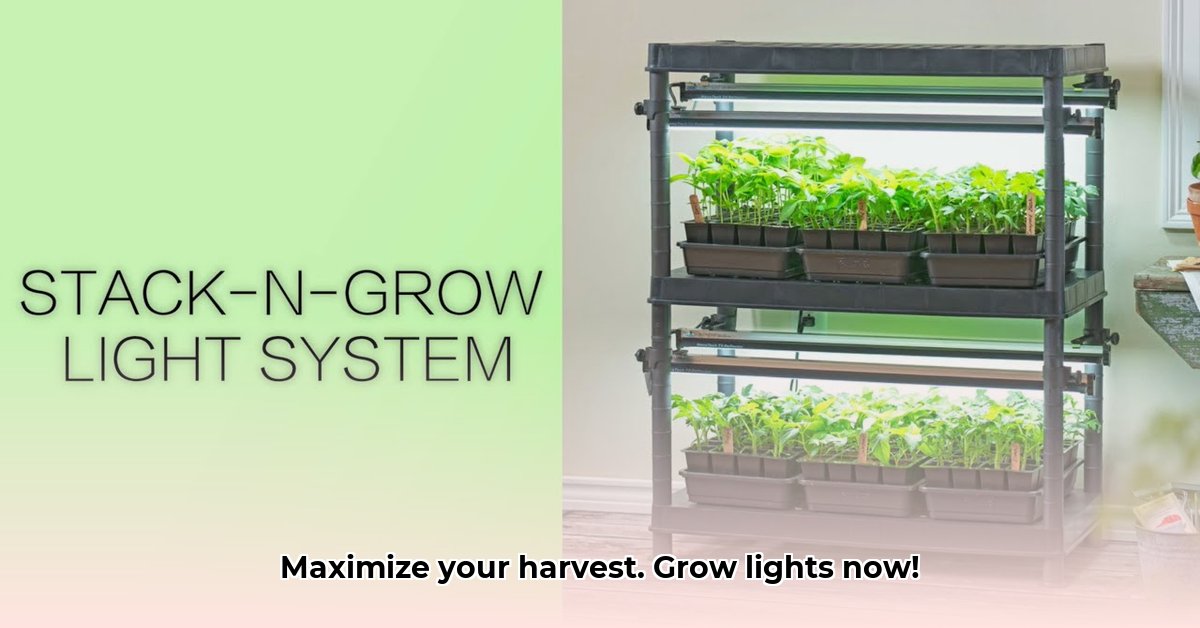
Ready to cultivate healthier, more productive plants? This guide explores how grow lights from Tractor Supply can revolutionize your gardening, regardless of your experience level. We'll cover selecting the right light, setting up your system, maintaining optimal conditions, and analyzing the long-term cost-effectiveness. Forget the limitations of unpredictable weather; with the right grow lights, you're in control. For additional resources on sustainable gardening, check out this helpful site.
Understanding LED Grow Lights: The Science of Plant Growth
LED grow lights offer significant advantages over traditional methods, particularly in terms of energy efficiency and spectrum control. Unlike older technologies like high-pressure sodium (HPS) lamps, LEDs consume significantly less energy, resulting in lower electricity bills and a reduced environmental footprint. But the true power lies in their ability to deliver precisely tailored light spectrums, mimicking the sun's power but with greater precision.
Plants, akin to picky eaters, don't simply need any light; they require the right kind at the right time. Different wavelengths trigger specific growth processes. For instance, 660nm red light plays a crucial role in flowering and fruiting. Numerous studies demonstrate its ability to significantly increase yields in various plant species, acting as a potent "bloom booster." This isn't mere marketing; it's supported by substantial scientific evidence. Research shows plants exposed to optimal 660nm red light during critical stages exhibit not only increased yields but often improved overall quality and nutritional content as well.
Choosing the Right Grow Lights from Tractor Supply: Finding Your Perfect Match
Selecting the appropriate grow light from Tractor Supply requires careful consideration of several key factors:
Wattage (Power): This determines light intensity. Higher wattage lights are suitable for larger plants or those in the flowering stage, providing the necessary energy for robust growth and fruit production. Lower wattage options are ideal for seedlings or smaller plants with less intense light needs. Tractor Supply offers a diverse selection, allowing you to match wattage to your specific requirements and budget.
Spectrum (Color): Full-spectrum lights, mimicking natural sunlight, support healthy vegetative growth (leaf and stem development). However, for flowering and fruiting, lights with a higher concentration of 660nm (red) light are often preferable. Carefully examine the specifications to ensure the light spectrum aligns with your plant's growth stage. The inclusion of 660nm red light is a key factor for maximizing yield.
Features: Additional features such as dimming capabilities (allowing intensity adjustment), adjustable height (maintaining optimal plant-light distance), and timers (automating light cycles for consistency) enhance usability and optimization. These aren't strictly necessary but can improve convenience and efficiency.
Setting Up Your Grow Light System: A Step-by-Step Guide
Proper setup is critical for maximizing your grow lights' effectiveness. Follow these steps for optimal results:
Strategic Placement: Position lights to ensure uniform light coverage across your plants. Avoid concentrating light on a single area; aim for consistent illumination to prevent uneven growth and potential deficiencies.
Optimal Distance: Maintain the recommended distance between your lights and plants. This information is usually found in the manufacturer's instructions. Starting slightly farther away and gradually decreasing the distance is recommended; closely monitor your plants for signs of stress (wilting, leaf discoloration) during this process.
Environmental Control: Maintaining consistent temperatures and humidity levels is essential. High temperatures, especially when combined with intense lighting, can damage plants. Proper ventilation is vital for regulating temperature and preventing overheating. Use fans or other ventilation strategies as needed.
Maintenance and Troubleshooting: Keeping Things Running Smoothly
Regular maintenance ensures your grow lights function at peak efficiency, optimizing your plant's growth potential.
Regular Cleaning: Periodically wipe down your grow lights to remove dust accumulation; this dust reduces light penetration and diminishes effectiveness.
Bulb Replacement: LEDs possess a long lifespan, but eventually require replacement. Monitor light output and replace any that dim significantly; reduced light output directly impacts plant growth and yield.
Troubleshooting: If you notice unexpected growth patterns, systematically check several factors: light intensity, distance, environmental conditions, and light cycles. Addressing issues promptly prevents further problems.
Cost-Benefit Analysis: The Long-Term Investment
While the initial investment in LED grow lights might appear higher than some traditional methods, the long-term benefits—energy savings and increased yields—often outweigh this.
| Feature | Traditional Lighting (e.g., HPS) | LED Grow Lights (Tractor Supply) |
|---|---|---|
| Energy Efficiency | Low | High |
| Initial Cost | Lower | Higher |
| Operating Cost | Significantly Higher | Significantly Lower |
| Lifespan | Much Shorter | Much Longer |
| Environmental Impact | Higher | Lower |
The lower energy consumption and significantly longer lifespan of LEDs translate into substantial cost savings over time. The increased yields often lead to a quick return on investment. Consider government incentives or rebates for energy-efficient technologies, potentially further reducing costs. Careful planning and efficient usage will ensure LED grow lights represent a highly valuable investment for any gardener.
Remember, while the right lighting is pivotal for successful plant growth, healthy soil, appropriate watering, and proper nutrition remain critical factors for a thriving garden. Explore the options at Tractor Supply (1) and begin enhancing your gardening success today!